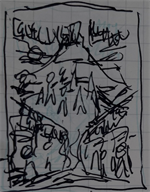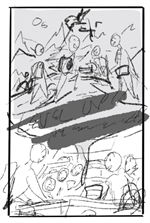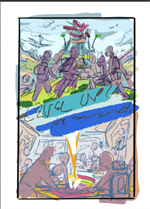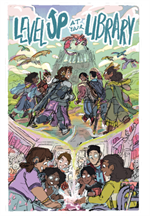September 2024 | Volume XLII, Issue 3 »
A Conversation with Carey Pietsch
September 3, 2024
Becca Boland, Illinois Library Association
Before you start reading, I need to confess. I am an exceptionally biased interviewer. Carey Pietsch was the first artist I recruited in my role as iREAD Content and Development Manager, and therefore will always hold a special place in my heart. I went into this discussion very excited to learn more about not only her creative process but also her as an artist and person.
You may already be familiar with Pietsch’s work on The Adventure Zone graphic novel series but the opportunity to contribute to iREAD was more than just another project for her – it was a heartfelt connection to her youth and a testament to the power of libraries. She was an endlessly gracious and generous contributor and an absolute delight to work with.
“This is my first time getting to work with a library, and I couldn’t have asked for a better experience. Everyone I’ve had the chance to speak to or work with on the iREAD team has been SUCH a delight, and working with you has been honestly such a joy ‒ this is my favorite of all the freelance jobs I’ve ever gotten to work on! It’s set an incredibly high bar for all my future projects.”
Pietsch’s artistic process is a combination of both “traditional” and digital mediums, each step built on a foundation of storytelling and visual narrative. She goes between rough sketches and digital refinement. This blend of analog and digital allows Pietsch to maintain the spontaneity of her initial sketches while harnessing the precision of digital tools for final touches and adjustments ‒ a process that ensures her artwork conveys her initial vision. She was generous enough to share insights into her process, both generally and specifically, for the art she created for iREAD. She discussed everything from the tools she used to her step-by-step process in creating the poster for Level Up at Your Library:

“Whatever I’m working on, I always start from the fastest, tiniest, loosest, messiest possible drawing.
“I think that was about an inch tall? Usually, nobody else gets to see these roughs; I spend a lot of time noodling in my sketchbook in pen and pencil to try to get ideas down before I can second-guess them. My comics all have starting points that look a lot like these too!
“I work in a mix of traditional and digital mediums, but after I draw a tiny rough on paper in my sketchbook, I generally take it to my iPad or computer to do a very slightly more legible pass.

"Then I did a slightly tighter rough pass with rough colors to pass along to the iREAD team for feedback and notes! I ended up changing the number of kids at the table, moving the text to the top of the poster, and shifting the overall composition a little bit to balance out that empty space. It’s like a mini spot-the-differences game!
"After that, I either ink it digitally or print it out and ink on paper with a variety of nib and brush pens. For iREAD, I knew I wanted to work digitally so any fixes/notes would be easier to manage. You can see that some of these inks ended up tweaked at the color pass, but mostly it’s pretty set!

"After that, I got to color! I already had a rough color design from an earlier stage, but now it’s time to take a neat pass at flat colors and add highlights and a little texture. I think I meant neatER pass, really – I have a super-rough color pass that was my very first color thumbnail thought, and the slightly cleaner version I handed in to the committee for review.
"But for a finished linework-heavy illustration, I then have to go through the process of actually coloring the lines I’ve ended up with, following the plan of that color rough, but more neatly. I love coloring! It’s a treat for me in both comics and illustrations; making a solid color rough feels like solving a puzzle, and then final colors are a really fun execution of that plan.

"Choosing colors is a really fun challenge! I took several oil painting classes at Fleisher Community Art Center and Community College Philadelphia, and I honestly think those helped me with color, even digital color, more than anything else. Having to think about using a limited palette and mixing your own colors from a few tubes is a really good exercise!
"When I’m working on color, I always start with a very tiny thumbnail sketch. Here’s an example of some I did for an earlier The Adventure Zone Graphic Novel.
"I’m thinking first of color as a way to establish mood or tone, and then to tell you a little bit about local color after that! Starting very small helps me keep the big mood of the piece in mind.

"For Level Up At Your Library, I wanted to have a clear distinction between the library and fantasy worlds, but also to establish a mood of fun adventure in both. In both halves of the poster, the main characters use a big, bright, varied palette, while the background is pushed back into the distance by using a more limited palette; in the fantasy world it skews blue and in the library more towards purple. I think that helps it feel like two distinct but connected worlds!"

It is probably no surprise that color plays a pivotal role in Pietsch’s art. Whether it is Dungeons & Dragons-inspired illustrations for iREAD or delving into personal projects, it shapes both mood and atmosphere.
When asked about the mediums she prefers, Pietsch shared, “In terms of how I’m using traditional media – for short comics, sometimes I ink traditionally, then scan those inks into the computer for tweaks and tones. In those cases, I’ll blow up my thumbnails really large on the computer, print them out, then put them over a lightbox with a sheet of nicer paper on top, and I’ll pencil and ink onto that nicer paper using my rough thumbs as a guide.”
I was surprised and delighted to hear about her process. I assumed that she would keep plugging away, like so many creative folks do, so I was thrilled to hear that she makes time to care for herself as well. “In terms of my art practice outside of specific projects: I do draw almost every day, but I also take time off for wrist health and mental health.”
It is no surprise that Carey’s creativity was the perfect match for this project. Pietsch’s connection to libraries runs deep, rooted in childhood memories of exploration and discovery. “Libraries are really precious to me! Growing up, I was really lucky to have not only a strong local library (Ossining Public Library in Ossining, NY) but also parents who had the time and resources to take their kids to the library about once a week, which was a really special treat.” These early experiences shaped Pietsch’s artistic sensibilities, fostering a love for storytelling and visual expression that continues to define her work today. These experiences also continue to fuel her love for libraries because they were so pivotal to her childhood.
For Pietsch, art transcends mere illustration; it’s a medium for exploration and empathy. And she finds that especially relevant in fantasy-based works. “I’m interested in using fantasy as a tool to explore interpersonal relationships in new settings. Using magic or fairy-tale rules to learn empathy and express vulnerability is a theme that comes up again and again when I’m writing.”
These themes can be found throughout Pietsch’s work. It allows her to infuse her work with depth and emotional resonance. “Across all settings, what really makes stories click for me is the relationships between characters, and whether those characters feel like true, full, fleshed-out people.”
Pietsch’s journey as an artist is intertwined with a community of fellow creators and collaborators. This collaborative spirit extends to her involvement with writing groups and book clubs, where she finds inspiration and camaraderie. “I started a local writing group several years ago! We’re a bunch of mostly-local cartoonists, so everyone both writes and draws, which is really helpful when looking for feedback on graphic novel outlines and scripts specifically.”
As Pietsch continues to expand her artistic horizons, she remains deeply engaged in projects that resonate with her creative vision and values. When asked, “What is your dream project?” Pietsch said, “Honestly, iREAD was really a dream project to me! It’s been so cool to see the program work with more cartoonists over the past couple years, and I’d wondered about whether it might be something I could do someday.”
As Carey Pietsch’s artistic journey continues to unfold, one thing remains clear: her passion for storytelling and community shines through in every stroke of her pen and every pixel. From libraries to fantasy realms, her work resonates with readers, inviting them into worlds where creativity knows no bounds.
For those embarking on their own creative journeys, Pietsch offers sage advice: “Making time to play in your art practice is essential for health and career longevity. You have to be a person first and an artist second.”
Carey Pietsch stands as a beacon of inspiration ‒ a testament to the transformative power of storytelling, art, and the enduring magic of libraries. We are so lucky that she shared some of that inspiration with iREAD.

 iREAD Summer Reading Programs
iREAD Summer Reading Programs Latest Library JobLine Listings
Latest Library JobLine Listings